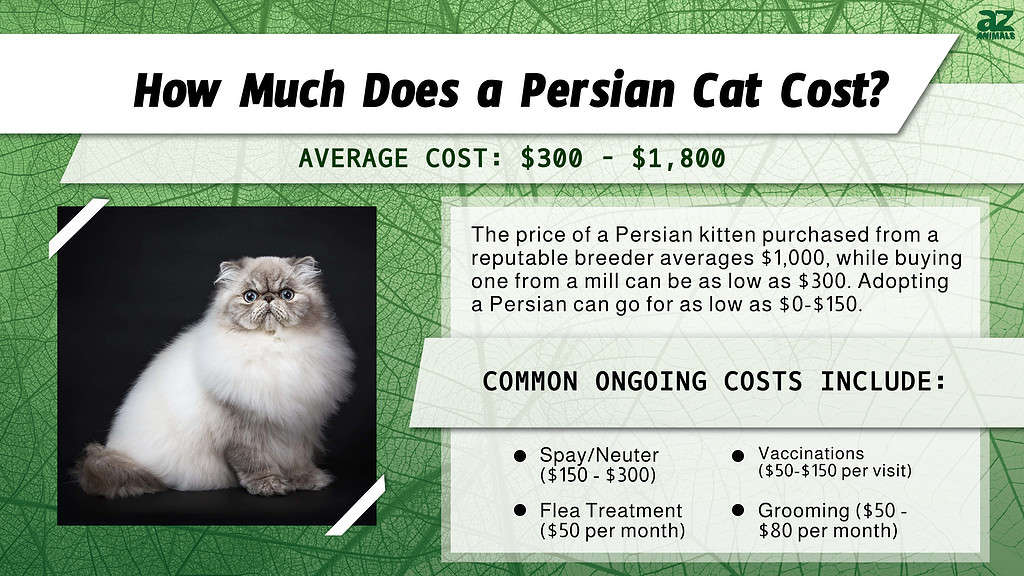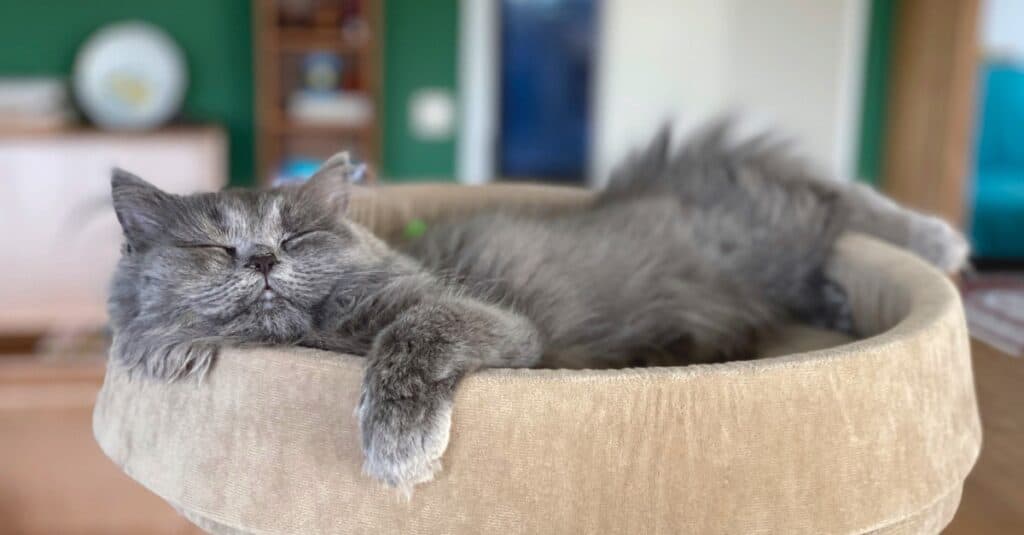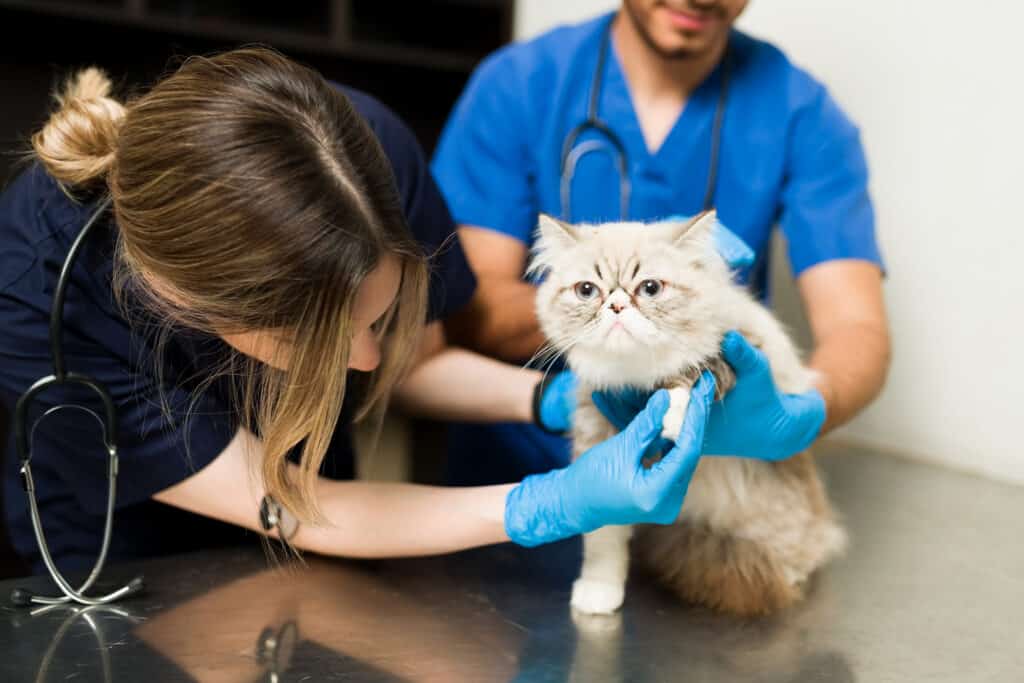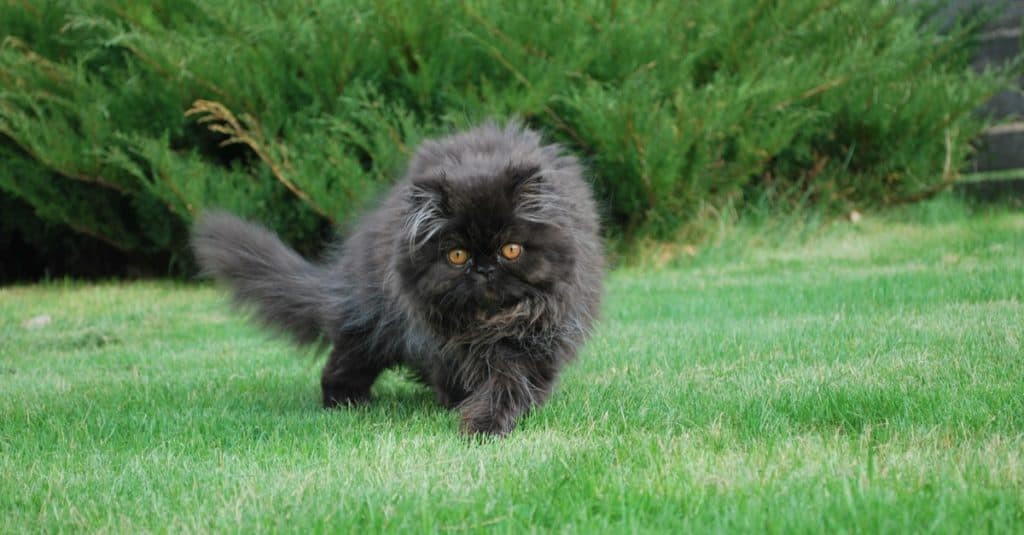A Persian cat is a breed of domestic cat that is known for its long, luxurious fur and distinctive facial features. They have a round face with large, expressive eyes and a short nose. Their body is typically stocky and muscular, with short legs and a broad chest. Their fur is thick and silky, often requiring daily grooming to prevent matting or tangling.
Persian cats come in a variety of colors and patterns, including red, brown, silver, blue, and cream. They are generally considered to be one of the most beautiful breeds of cats due to their striking appearance.
While they may be high maintenance when it comes to grooming needs, many people find that the affectionate nature of Persian cats makes them well worth the investment.

With proper care from an experienced veterinarian who specializes in feline health issues–such as respiratory problems commonly seen in this breed–these furry felines can provide years of loving companionship for those willing to invest time into their upkeep.
How Much Does a Persian Kitten Cost?
When considering the cost of purchasing a Persian kitten, prices can vary significantly depending on the type of breeder you choose. On average, you can expect to pay around $1,000 for a Persian kitten from a reputable breeder. However, if you opt for a kitten from a kitty mill or backyard breeder, you may be able to find one for as little as $300. And, of course, adoption is always a wonderful choice. Adoption fees range from $0 to $150, on average. If you are willing to adopt an older Persian cat, there is often no adoption fee at all.

Overall, when considering purchasing a Persian kitten, it’s essential to weigh both short-term costs and long-term potential expenses.
©iStock.com/Vera Duchovskaja
It’s crucial to keep in mind that choosing a cheaper option may come with additional expenses down the line. Kittens from less reputable breeders are often more likely to develop health problems or behavioral issues that require costly veterinary care and training.
On the other hand, true breeders who prioritize responsible breeding practices and invest in their kittens’ health and socialization may charge upwards of $1,800 for their kittens. While this is certainly more expensive upfront than other options, it could ultimately save money in the long run by reducing future vet bills.
Overall, when considering purchasing a Persian kitten, it’s essential to weigh both short-term costs and long-term potential expenses associated with different types of breeders before making your decision.
| Type | Average Price |
|---|---|
| Older Persian Cat Adoption | Often $0 – $75 |
| Persian Kitten Adoption | $150 – $400 |
| Backyard Breeder or Mill | $300 – $500 |
| Reputable Breeder | $1,200 – $1,800 |
Other Factors That Influence the Purchase Price of a Persian
When considering the purchase price of a Persian cat, it’s important to take into account factors beyond just their physical appearance and personality traits. Two key elements that can greatly influence the cost are the cat’s lineage and location.
Firstly, lineage plays a significant role in determining how expensive a Persian cat will be. Cats with an extensive pedigree or those that come from generations of champion show cats, are likely to have higher price tags than those without such prestigious backgrounds. This is because breeders invest substantial time and money into breeding high-quality Persians for shows, so they understandably charge more for their offspring. You may pay as much as $2,500 to take one of these cats home.
Secondly, location can also impact the purchase price of a Persian cat. In general, areas with higher costs of living tend to have correspondingly higher prices for pets due to increased demand and expenses associated with caring for them. Additionally, certain regions may have more specialized breeders who produce rare or unique variations of Persians that fetch top dollar on the market.
Overall, when evaluating the cost of buying a Persian cat, it’s essential to consider these additional factors beyond just basic breed standards. By doing so, you’ll be better equipped to make an informed decision about where and how much to pay for your feline friend while staying within your budgetary constraints.
Cost of Vaccination and Other Medical Expenses for Persian Cats
When deciding to bring a Persian cat into your home, consider the various expenses that come along with pet ownership. Beyond the initial purchase cost, there are several ongoing medical expenses and grooming needs that should be taken into account.

When deciding to bring a Persian cat into your home, consider the various expenses that come along with pet ownership.
©Beach Creatives/Shutterstock.com
Spay and Neuter
One of the most important medical expenses for any cat owner is spaying or neutering their pet. Not only does this help control overpopulation, but it also has health benefits for your pet, such as reducing the risk of certain cancers and behavioral issues like spraying or roaming. The cost of spaying or neutering a Persian cat can vary depending on location and veterinary clinic, but it typically ranges from $200-$400.
Vaccinations
Another crucial expense for any responsible pet owner is vaccinations. Regularly vaccinating your Persian cat against common diseases like rabies, distemper, and feline leukemia virus (FeLV) can help keep them healthy and prevent costly illnesses down the line. Vaccination costs will depend on which vaccines are administered by your veterinarian but generally range from $50-$150 per visit.
Flea Treatment
Flea treatments are another recurring expense to consider when caring for a Persian cat. Fleas not only cause discomfort for pets but can also lead to more serious health issues, such as anemia or tapeworms, if left untreated. Monthly flea prevention medications can range in price depending on brand name versus generic options and whether they include additional parasite protection against ticks or heartworms. The average cost is $50 per month.
Grooming
While Persian cats are undeniably adorable and make wonderful pets, their long, luxurious coats require regular grooming in order to prevent matting and hairballs. Depending on the length of your cat’s fur, you may need to brush them every day or at least a few times a week. In addition to brushing, you may also need to trim their nails and clean their ears as part of their grooming routine.
While all of this can be done at home with the right tools and some patience, many Persian cat owners choose to take their feline friends to professional groomers for regular appointments. These visits can add up over time, so it is important to factor them into your overall budget when considering the cost of owning a Persian cat. The average monthly grooming expense for a Persian cat is $50-80 per month.
Other potential medical expenses include x-rays, deworming, ultrasounds, ID tags, and microchips.
| Medical Expense | Average Price |
|---|---|
| Spay/Neuter | $150 – $300 |
| X-Rays | $100 – $250 |
| Rabies Vaccine | $15 – $25 |
| Feline Leukemia/FIV Test | $30 – $50 |
| Flea and Tick Treatments | $50 per month |
| Dewormer | $20 – $50 |
| Ultrasound | $250 – $500 |
| Microchip | $50 -$75 |
| Grooming | $50 – $80 per month |
| Insurance | $30 – $35 per month |
Cost of Food and Supplies for Persian Cats

When deciding to bring a Persian cat into your home, consider the various expenses that come along with pet ownership.
©iStock.com/pat138241
The cost of food and supplies for Persian cats can vary depending on several factors, such as the size, age, and overall health of the cat. However, on average, you can expect to spend around $20-30 per month on high-quality cat food that meets all dietary needs.
In addition to food costs, there are also other necessary supplies that you will need to purchase for your Persian cat. These may include litter boxes and litter (which may cost around $10-$15 per month), scratching posts or pads (ranging from $10-$50 each), toys ($5-$20 each), grooming tools such as brushes and combs ($10-$40 total), nail clippers ($5-$15 each) and dental care products like toothbrushes and paste ($5-$25 total).
These costs are just an estimate based on typical expenses associated with caring for a Persian cat. Actual expenses may be higher or lower depending on individual circumstances. Regardless of the exact amount spent, investing in quality food and supplies is essential in ensuring your beloved feline friend stays healthy and happy for years to come.
| Supplies | Average Cost |
|---|---|
| ID Tag and Collar | $15 |
| Cat Bed | $30 |
| Cat Carrier | $30 – $50 |
| Nail Clippers | $7 – $10 |
| Brush | $10 – $12 |
| Litter Box | $20 |
| Litter Scoop | $10 |
| Litter Box Liners | $15 per month |
| Toys | $25 – $35 |
| Food and Water Bowls | $20 – $30 |
| Cat Food | $10 – $20 per month |
| Cardboard Scratch Pads | $10 per month |
How Much Does It Cost to Insure a Persian Cat?
When considering pet insurance for your Persian cat, it is important to factor in the monthly cost. On average, pet insurance for a Persian cat can range from $30-35 per month depending on various factors such as age, health history, and coverage plan. Some plans may have deductibles or co-pays that also affect the overall cost per month. It’s important to carefully review each plan and compare prices before making a decision. Additionally, keep in mind that while pet insurance may seem like an unnecessary expense, unexpected veterinary bills can quickly add up, and having insurance can provide peace of mind in case of accidents or illnesses.

Owning a Persian cat can be a rewarding experience, but it’s wise to recognize the financial commitment that comes with it.
©CtrlAltDelicious/Shutterstock.com
Monthly Coast to Own a Persian Cat
Owning a Persian cat can be a rewarding experience, but it’s wise to recognize the financial commitment that comes with it. According to our research, the average monthly cost of meeting your Persian’s basic needs ranges between $320 and $450. This includes expenses such as food, litter, grooming supplies, and toys.
However, unforeseen circumstances may arise where your furry friend requires medical attention from a veterinarian. Whether it’s due to illness or an accident, these unexpected visits can add significant costs to your monthly budget. It is highly recommended that pet owners consider purchasing insurance for their cats to mitigate some of these expenses.
While owning a Persian cat can be expensive at times, the companionship and joy they bring into our lives are priceless. By understanding the financial responsibilities associated with pet ownership and being prepared for any unexpected events that may occur along the way, you’ll be able to provide the best care possible for your feline companion without breaking the bank.
Thank you for reading! Have some feedback for us? Contact the AZ Animals editorial team.








